Graflex reflex models
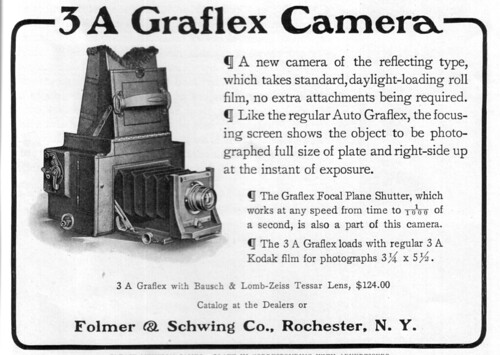
|
| 1907 advertisement scanned by Uwe Kulick (Image rights) |
The Graflex is a large single-lens reflex camera, first produced in 1898 in New York, N.Y by the Folmer & Schwing Manufacturing Company of New York, NY.
History
In the early years the Graflex was made in a variety of formats, settling down in the 1920s to a number of long-lived models which share the same basic design and mode of operation. Most models were for sheet film, some were made for usa with rollfilm.
The Graflex vertical focal-plane shutter consists of a single curtain with a series of four slits of widths from 1½ inches to 1/8; inch. The shutter spring can be set to six different tensions. Different combinations of slit width and spring tension allow a choice of 24 speeds ranging from 1/10 to 1/1000 as well as Time. When the shutter is released, the mirror swings up and triggers the curtain to travel from top to bottom. In the last models the tension settings were reduced to a simple High and Low, permitting 8 different speeds.
The standard lenses are for the most part f/4.5 Kodak Anastigmats and, in later years, Kodak Ektars. The rare Series C, a 3¼×4¼ model, is equipped with an immense f/2.5 Taylor-Hobson-Cooke lens.
All Graflex models feature the distinctive tall focusing hood that folds under the lid of the camera. The reflex finder is the origin of the model name Graflex—which was later applied to the company as a whole, and to the Graflex Speed Graphic series (which did not employ reflex viewing).
In 1905 Graflex was purchased by Eastman Kodak and relocated to Rochester, New York[1]. In 1927 Kodak divested itself of the Folmer-Schwing division, which re-organized as the Folmer-Graflex corporation. Folmer-Graflex, which also manufactured the Graphic press cameras, was finally dissolved in 1973. The last of the Graflex SLRs was produced in 1963.
Models

|
| 3¼×4¼ Super D image by big-film (Image rights) |

|
| Advertisement for Kodak 1A Graflex scanned by Mario Groleau (Image rights) |
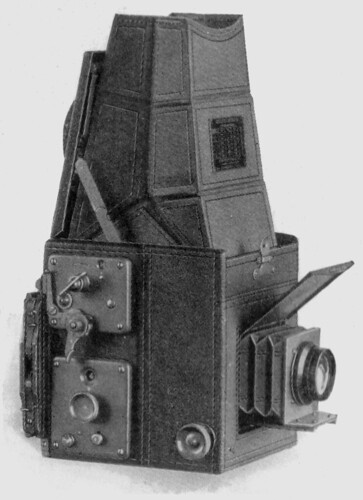
|
| 4x5 Graflex Series B scanned by Uwe Kulick (Image rights) |

|
| from 1929 Kodak catalogue scanned by Geoff Harrisson (Image rights) |
Most Graflex cameras were made with a revolving (actually rotating) back, abbreviated to RB, which allowed shooting in vertical or horizontal orientations without turning the camera. All were made of straight-grain Honduras mahogany covered with black Morocco leather. The Graflex back is unique: the various film holders and magazines that fit the Graphic cameras will not fit the Graflex cameras and vice-versa.
- The Auto Graflex 3¼ × 4¼ (1905)
- The Naturalist Graflex 4 × 5 (1907–1921)
- The RB Auto series in addition features a greater bellows extension, allowing the use of longer telephoto lenses. It was produced in 3¼ × 4¼ (1909-1942) and 4 × 5 (1909-1940) formats.
- The 5 × 7 RB Home Portrait Graflex (1912–1940) has a slower top shutter speed of 1/500. Besides its function for portrait photography outside the studio, it was used with "Big Bertha" telephoto lenses of focal lengths up to 40 inches for long-distance sports photography.
- The RB Series B was produced in 2¼ × 3¼ (1923-1952), 3¼ × 4¼ (1923-1942) and 4 × 5 (1923-1940) formats.
- The fixed-back Series B was produced in 3¼ × 4¼ (1925-1937), 4 × 5 (1925-1937) and 5 × 7 (1923-1932) formats.
- The 4 × 5 Graflex Series B (1924) had a built-in Kodak Anastigmat 6 3/8 inches f4.5 lens
- The Graflex Series C was produced in 3¼ × 4¼ (1926–1935) which featured a Taylor-Hobson Cooke Anastigmat 6½ inch f/2.5 lens
- The RB Series D, which features interchangeable lens boards, was produced in 3¼ × 4¼ (1928-1941) and 4 × 5 formats (1928-1947).
- The RB Super D, which features a semi-automatic diaphragm, and flash synchronization, was produced in 3¼ × 4¼ (1941-1963) and 4 × 5 (1948-1957) formats.
Rollfilm variants
- The 3A Graflex Camera (3¼ × 5½, 1907) was a folding bed variant
- The 1A Graflex Autographic (2½ × 4¼) a small folding bed camera with autographic feature
- The National Graflex (1931-1940) has a metal body in a shape that resembles a lunch box and produces 10 exposures measuring 2 1/8 × 2½ on 120 roll film. Shutter speeds range from 1/30 to 1/500 and B.
 |
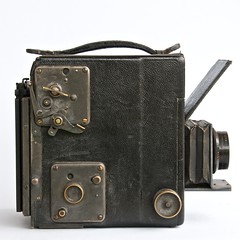 |
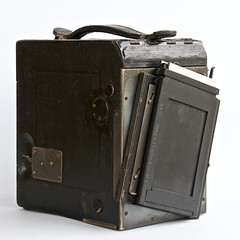 |
 |
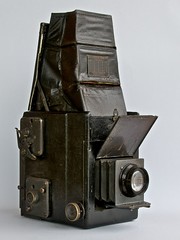 |
RB Series B 3¼×4¼ (1923-1942)
images by Dirk HR Spennemann (Image rights)
Notes
- ↑ McKeown, James M. and Joan C. McKeown's Price Guide to Antique and Classic Cameras, 12th Edition, 2005-2006. USA, Centennial Photo Service, 2004. ISBN 0-931838-40-1 (hardcover). ISBN 0-931838-41-X (softcover). Page365.
Further reading
Morgan, Willard D. and Lester, Henry M. Graphic Graflex Photography. New York, 1954.
Links
- http://www.graflex.org
- http://en.wikipedia.org/wiki/Graflex
- World of Graflex - Lots of photos
- Super D and other Graflex Reflex Cameras.
- Graflex model instruction models at www.orphancameras.com
- Graflex ads and original pricing at www.butkus.us
- Graflex instruction manuals (English) at www.butkus.us
- Graflex RB tele on www.collection-appareils.com by Sylvain Halgand (in French)